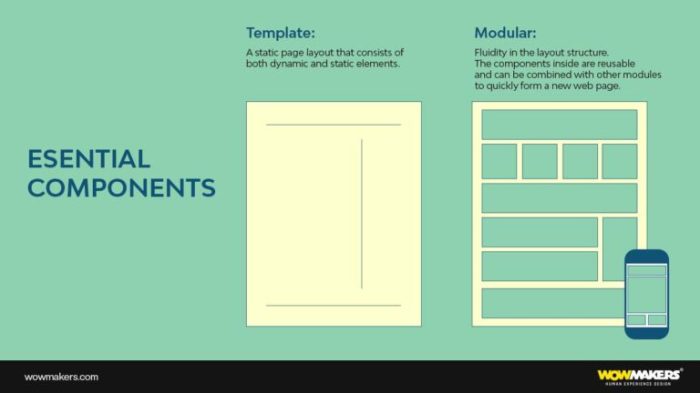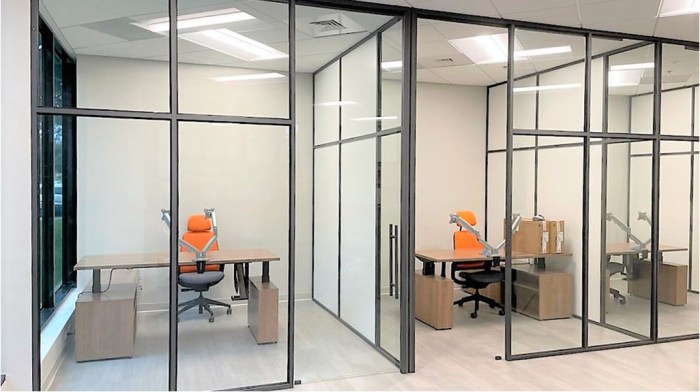Modular design offers a powerful approach to building flexible and scalable systems. By breaking down complex projects into smaller, independent modules, developers and designers gain increased efficiency, maintainability, and adaptability. This exploration delves into seven key strategies for harnessing the power of modularity, examining its applications across diverse fields and providing practical guidance for implementation.
We’ll cover the fundamental principles of modular design, outlining best practices for creating reusable components. This includes exploring various approaches like component-based and object-oriented methodologies, highlighting the importance of standardization and compatibility. We’ll then move into real-world examples, showcasing how modularity solves unique challenges and facilitates future expansion in dynamic environments.
Understanding Modular Design Principles

Modular design is a powerful approach to creating flexible and scalable systems. It emphasizes breaking down complex systems into smaller, independent, and interchangeable modules. This approach offers significant advantages in terms of maintainability, adaptability, and cost-effectiveness. By understanding and applying its core tenets, designers can create robust and easily adaptable solutions across diverse applications.
Modular design’s core tenets revolve around the concept of independent, interchangeable components. Each module performs a specific function and can be easily replaced, upgraded, or combined with other modules without affecting the overall system’s functionality. This inherent flexibility allows for easier scaling, customization, and maintenance. The benefits extend to reduced development time, lower costs associated with changes, and increased resilience to failures, as problems are often isolated to a single module.
Examples of Modular Design Implementations
Modular design finds applications across numerous industries. In software development, Lego-like components are commonly used to build complex applications. Consider the modular nature of WordPress plugins: each plugin adds a specific function without altering the core functionality. Similarly, in manufacturing, modular furniture systems allow for customized configurations by combining pre-designed components. IKEA’s flat-pack furniture is a prime example, offering consumers a vast array of choices through simple assembly of standardized parts. In the automotive industry, modular platforms allow manufacturers to create a range of vehicles (sedans, SUVs, etc.) based on a common underlying architecture, reducing development costs and time-to-market.
Identifying Key Modules within a System
Identifying key modules requires a systematic approach. Begin by analyzing the overall system’s functionality and breaking it down into its core functions. Each distinct function should be considered a potential module. Next, evaluate the level of interdependence between these functions. Modules should be as independent as possible, minimizing reliance on other modules’ internal workings. This independence facilitates easier replacement and modification. Finally, consider the potential for reuse. Designing modules with broad applicability increases their value and reduces redundancy in future projects. A well-defined modular system will exhibit clear interfaces between modules, allowing for easy integration and replacement.
Hypothetical Modular Furniture System
Let’s design a modular furniture system for a modern apartment. The system comprises three core modules: seating, storage, and shelving. The seating module could include individual chairs, sofas, and ottomans, all based on a standardized connection system. The storage module would offer various units like drawers, cabinets, and chests, again with a consistent interface for easy integration. The shelving module would consist of various shelf sizes and configurations, allowing for customization based on individual needs. All modules would utilize a standardized connection mechanism, ensuring compatibility and flexibility in arrangement. The customer could mix and match modules to create unique configurations, adapting to their evolving needs and space constraints.
Characteristics of Effective Modular Components
| Feature | Description | Example | Benefit |
|---|---|---|---|
| Independence | Modules operate independently, minimizing dependencies on other modules. | A software library providing specific functionality without relying on other libraries’ internal workings. | Easier maintenance, modification, and replacement. |
| Interchangeability | Modules can be easily replaced or upgraded without affecting the overall system’s functionality. | Replacing a faulty component in a piece of machinery with an identical replacement. | Reduced downtime and maintenance costs. |
| Standardization | Modules adhere to common standards and interfaces, ensuring compatibility. | Using standardized connectors in a modular electronics system. | Simplified assembly and integration. |
| Reusability | Modules can be reused in different systems or applications. | A software module used in multiple projects. | Reduced development time and costs. |
Implementing Modular Design

Implementing modular design effectively hinges on strategic planning and the adoption of suitable techniques. A well-structured modular system enhances maintainability, scalability, and reusability, ultimately leading to more efficient and robust software or design projects. This section delves into practical strategies and techniques for achieving successful modular design implementation.
Successful modular design requires careful consideration of several key aspects. The design process should emphasize creating independent, self-contained modules that interact through well-defined interfaces. This approach simplifies development, testing, and maintenance, allowing for easier updates and modifications without impacting the entire system. Choosing the right approach, understanding dependencies, and establishing clear standards are critical for achieving a robust and flexible modular system.
Reusable and Interchangeable Module Design Best Practices
Designing reusable and interchangeable modules involves adhering to several best practices. Key considerations include defining clear interfaces, employing consistent naming conventions, and ensuring modules are loosely coupled to minimize dependencies. Furthermore, thorough documentation and comprehensive testing are crucial for ensuring the reliability and maintainability of the modules over time.
- Well-defined interfaces: Modules should communicate solely through clearly defined interfaces, preventing direct access to internal components. This promotes encapsulation and reduces the risk of unintended consequences from changes within a module.
- Consistent naming conventions: Employing a consistent naming scheme for modules, functions, and variables improves readability and maintainability. This helps developers quickly understand the purpose and function of each module.
- Loose coupling: Modules should be designed with minimal dependencies on each other. This reduces the impact of changes in one module on others, improving the overall system’s flexibility and resilience.
- Comprehensive documentation: Detailed documentation outlining module functionality, interfaces, and usage instructions is essential for efficient collaboration and maintainability.
- Thorough testing: Rigorous testing of individual modules and their interactions is vital to ensure the system’s stability and reliability.
Comparison of Component-Based and Object-Oriented Modular Design
Component-based and object-oriented approaches represent two distinct but often complementary methods for implementing modular design. While both promote modularity, they differ in their fundamental principles and implementation techniques. Understanding these differences allows for choosing the most appropriate approach based on the project’s specific needs and complexity.
| Feature | Component-Based Design | Object-Oriented Design |
|---|---|---|
| Focus | Independent, reusable components with well-defined interfaces | Objects encapsulating data and methods |
| Interaction | Components interact through interfaces | Objects interact through methods and inheritance |
| Abstraction | High level of abstraction, hiding internal implementation details | Abstraction through classes and interfaces |
| Example | UI widgets, software libraries | Classes and objects in Java, Python |
Standardization and Compatibility in Modular Systems
Standardization and compatibility are paramount for creating successful modular systems. Without these, integrating and reusing modules becomes significantly more difficult, hindering the advantages of modularity. Clear standards ensure interoperability and prevent conflicts between different modules.
- Interface standards: Defining and adhering to consistent interface standards ensures that modules can interact seamlessly.
- Data format standards: Using standardized data formats simplifies data exchange between modules.
- Version control: Implementing version control helps manage changes and ensure compatibility between different versions of modules.
Step-by-Step Guide for Designing a Modular System
Designing a modular system involves a structured process, progressing from initial concept to final implementation. Each phase requires careful planning and execution to ensure the resulting system is robust, maintainable, and scalable.
- Requirements Gathering: Clearly define the system’s overall functionality and identify potential modules.
- Module Design: Design each module, specifying its functionality, interfaces, and dependencies.
- Interface Definition: Define clear and consistent interfaces for communication between modules.
- Implementation: Develop each module individually, adhering to the defined design and interface specifications.
- Integration and Testing: Integrate the modules and perform thorough testing to ensure proper functionality and compatibility.
- Deployment: Deploy the modular system to the target environment.
- Maintenance and Updates: Continuously monitor and maintain the system, addressing issues and implementing updates as needed.
Managing Dependencies and Interactions Between Modules
Visualizing dependencies and interactions between modules using a flowchart provides a clear understanding of the system’s architecture and facilitates troubleshooting. This helps in identifying potential bottlenecks and simplifying the process of updating or modifying individual modules.
[Imagine a flowchart here. It would show boxes representing different modules, connected by arrows indicating data flow or function calls. For example, a “User Interface” module might send data to a “Data Processing” module, which then sends results to a “Database” module. Different arrow styles could represent different types of interactions, like synchronous or asynchronous communication.]
Applying Modular Design to Real-World Scenarios

Modular design, with its emphasis on independent, interchangeable components, offers significant advantages across diverse fields. Its application leads to increased efficiency, flexibility, and maintainability, ultimately reducing development time and costs while enhancing the overall quality of the final product or system. This section explores real-world applications, highlighting the unique challenges and solutions involved.
Modular Design in Software Development
Software development heavily benefits from modularity. Consider the development of a large-scale enterprise resource planning (ERP) system. A monolithic approach would involve a single, large codebase, making updates, debugging, and feature additions extremely complex and time-consuming. A modular approach, however, breaks down the system into smaller, independent modules – such as inventory management, human resources, and financial accounting – each with its own codebase and interface. This allows for parallel development, easier testing, and independent upgrades. Challenges include defining clear interfaces between modules and managing dependencies. Solutions include utilizing well-defined APIs and version control systems to ensure compatibility and prevent conflicts.
Modular Design in Manufacturing
The automotive industry provides a prime example of modular design’s impact on manufacturing. Cars are now often assembled from pre-fabricated modules, such as the engine, transmission, chassis, and body panels. This allows manufacturers to create different vehicle models using the same basic modules, reducing production costs and lead times. A key challenge lies in ensuring the seamless integration of modules from different suppliers, requiring strict adherence to standardized interfaces and quality control procedures. Solutions involve robust testing protocols and collaborative design processes among different manufacturers and suppliers.
Modular Design in Construction
Modular construction, using prefabricated building components, is transforming the construction industry. Buildings are assembled from pre-fabricated modules, including walls, floors, roofs, and even entire rooms. This approach reduces construction time, minimizes on-site waste, and improves quality control. Challenges include transportation logistics of large modules and ensuring structural integrity when joining prefabricated elements. Solutions involve sophisticated design software, precise manufacturing processes, and specialized transportation equipment.
Impact of Modularity on System Maintainability and Upgradeability
Modularity significantly enhances system maintainability and upgradeability. Because modules are independent, maintenance and upgrades can be performed on individual components without affecting the entire system. This reduces downtime, simplifies troubleshooting, and allows for iterative improvements. For example, updating a specific module in a software application requires only recompiling and deploying that module, unlike a monolithic system where a complete system rebuild might be necessary.
Modular System Design: Customizable Website Template
Let’s design a modular system for a customizable website template. The system comprises the following modules:
- Header Module: Contains the website logo, navigation menu, and search bar. It can be customized with different color schemes and layouts.
- Content Module: Displays the main website content, including text, images, and videos. It supports different content types and layouts.
- Sidebar Module: Provides supplementary information, such as news feeds, advertisements, or social media links. It can be enabled or disabled depending on user preferences.
- Footer Module: Includes copyright information, contact details, and links to other relevant pages. It can be customized with different styles and layouts.
These modules interact through a well-defined API. The header and footer modules are relatively static, while the content and sidebar modules are highly dynamic and adaptable to various content types. The system allows users to combine and customize these modules to create unique website designs.
Visual Representation of a Modular System
Imagine a central hub representing the website’s core functionality. Four distinct branches extend from this hub. The first branch represents the Header Module, displaying a customizable logo and navigation bar. The second branch represents the Content Module, showcasing a flexible layout for text, images, and videos. The third branch is the Sidebar Module, with configurable elements like social media feeds or advertisements. The final branch is the Footer Module, showing copyright information and contact details. Each branch is independently configurable and can be easily added, removed, or modified without affecting the other components. The connections between the hub and the branches represent the system’s API, enabling seamless data exchange between the modules.
Modularity and Future Expansion
Modularity facilitates future expansion and adaptation to changing requirements. Adding new features simply involves creating new modules and integrating them into the existing system. For example, adding an e-commerce module to our website template requires only developing the e-commerce module and integrating it with the existing content and payment gateway modules. Similarly, adapting to changing user preferences or technological advancements can be achieved by modifying or replacing individual modules, without requiring a complete system overhaul. This flexibility is crucial in today’s rapidly evolving digital landscape.
Final Review

Mastering modular design empowers creators to build robust, adaptable systems capable of evolving with changing demands. By understanding the core principles, implementing effective strategies, and learning from real-world applications, designers and developers can unlock the significant benefits of modularity. From software applications to physical products, the flexibility and scalability offered by modular design represent a significant advantage in today’s rapidly changing landscape.